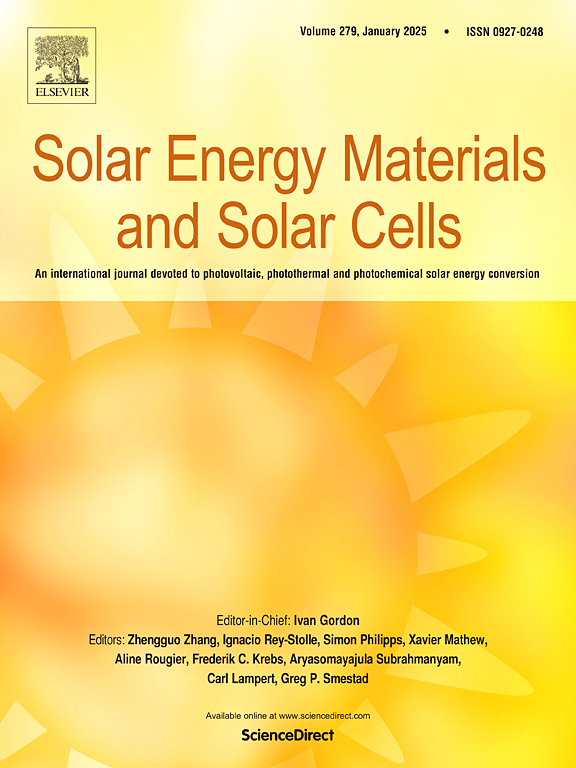提高阶梯式太阳能蒸馏器的性能:设计优化、材料集成和技术经济可行性的综合研究
IF 6.3
2区 材料科学
Q2 ENERGY & FUELS
引用次数: 0
摘要
获得清洁水仍然是一项重大的全球挑战,特别是在面临水资源短缺和能源有限的地区。太阳能蒸馏器提供了一种可持续的海水淡化解决方案,但传统的设计受到低产量和效率的影响,阻碍了广泛采用。本研究通过系统的设计修改和参数优化来提高阶梯太阳能蒸馏器(STSS)的性能,从而解决了这些局限性。研究人员研究了三种不同的吸收体几何形状——规则平面(RSTSS)、鳍状(FnSTSS)和波纹状(CrSTSS),以及各种排芯材料(黄麻、木炭、钢棉纤维和水珊瑚绒)和储热材料,包括砾石、黄沙和相变材料(PCM),如石蜡。实验和分析评估显示,与基准RSTSS系统(2695 mL/m2)相比,FnSTSS和CrSTSS配置的生产率分别提高了39% (3750 mL/m2)和54% (4155 mL/m2)。CrSTSS配置,当增加了水珊瑚绒排芯材料时,产生了5450毫升/平方米,比基线提高了91%。石蜡作为PCM的进一步整合将日产量提高到6940 mL/m2,热效率为59%,显示出卓越的潜在能量回收能力。技术经济分析证实,优化后的CrSTSS设计将淡水生产成本降低了87%,从每升0.20美元降至0.026美元。这些发现为推进太阳能蒸馏器技术的可持续海水淡化应用做出了重大贡献,为满足资源受限环境下的清洁水需求提供了一种经济可行的解决方案。本文章由计算机程序翻译,如有差异,请以英文原文为准。
Enhancing the performance of stepped solar stills: A comprehensive study on design optimization, material integration, and techno-economic feasibility
Access to clean water remains a critical global challenge, particularly in regions facing water scarcity and limited energy resources. Solar distillers provide a sustainable desalination solution, yet conventional designs suffer from low yield and efficiency, hindering widespread adoption. This research addresses these limitations by enhancing stepped solar still (STSS) performance through systematic design modifications and parametric optimization. Three distinct absorber geometries were investigated—regular flat (RSTSS), finned (FnSTSS), and corrugated (CrSTSS)—alongside various wicking materials (jute, charcoal, steel wool fibers, and water coral fleece) and thermal storage options including gravel, yellow sand, and phase change materials (PCM) such as paraffin wax. Experimental and analytical evaluations revealed that FnSTSS and CrSTSS configurations achieved respective productivity gains of 39 % (3750 mL/m2) and 54 % (4155 mL/m2) over the baseline RSTSS system (2695 mL/m2). The CrSTSS configuration, when augmented with water coral fleece wicking material, yielded 5450 mL/m2—a 91 % improvement over the baseline. Further integration of paraffin wax as PCM elevated daily output to 6940 mL/m2 with 59 % thermal efficiency, demonstrating superior latent energy recovery capabilities. Techno-economic analysis confirmed the optimized CrSTSS design reduces freshwater production costs by 87 %, from $0.20 to $0.026 per liter. These findings contribute significantly to advancing solar still technology for sustainable desalination applications, offering an economically viable solution for meeting clean water demands in resource-constrained environments.
求助全文
通过发布文献求助,成功后即可免费获取论文全文。
去求助
来源期刊

Solar Energy Materials and Solar Cells
工程技术-材料科学:综合
CiteScore
12.60
自引率
11.60%
发文量
513
审稿时长
47 days
期刊介绍:
Solar Energy Materials & Solar Cells is intended as a vehicle for the dissemination of research results on materials science and technology related to photovoltaic, photothermal and photoelectrochemical solar energy conversion. Materials science is taken in the broadest possible sense and encompasses physics, chemistry, optics, materials fabrication and analysis for all types of materials.
 求助内容:
求助内容: 应助结果提醒方式:
应助结果提醒方式:


